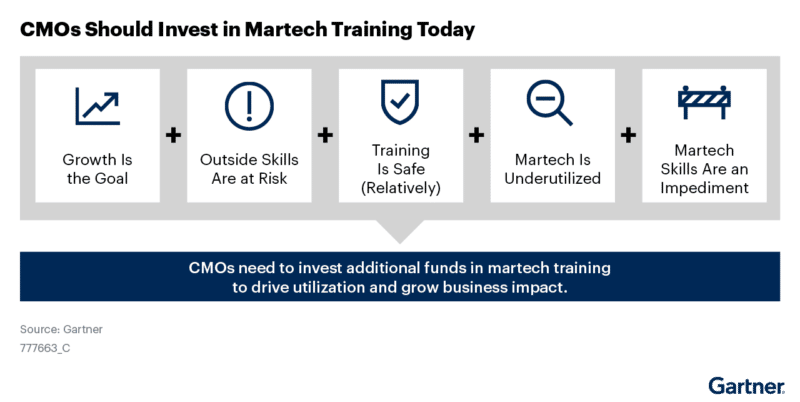Companies worldwide face the realities of the “triple squeeze” — inflation, a shortage of talent and supply chain disruptions. The marketing organization is certainly not immune from their increasing pressure.
In response to these economic headwinds, CFOs and CEOs prioritize investments focused on growth, which includes both digital technology (e.g., automation) and the workforce (e.g., training opportunities and other ways to retain talent).
One would think this focus signals good news for marketing technology budgets, but the C-suite doesn’t look so positively upon more investments in martech solutions.
Marketing technologies rank near the bottom (10th and 11th out of thirteen options) for their perceived ability to offset inflationary pressures over the next two years, according to recent Gartner research.
What’s more, martech utilization is shockingly low. Marketers report only using 42% of their martech stack capabilities. This is why they are struggling to demonstrate its ROI.
Likewise, martech is among the top three capability gap areas cited by CMOs in the latest Gartner CMO Spend survey.
That’s where the business’ focus on the workforce and training comes in.
CMOs should invest in martech training
Many organizations have an opportunity to invest additional funds in martech training to drive better utilization and business value.

If talent and technology are top-of-mind for the C-suite, how can CMOs use the current macroeconomic environment to align their own strategies and close the martech skills gap?
In theory, CMOs can look both internally and externally to close the talent gap, but we encourage them to think internally first. CMOs looking to contractors and consultants likely face internal resistance as these are two of the three most common areas where CFOs plan to make cuts.
Where martech training can make an impact
CMOs need to cultivate adjacent, complementary skills. The real gaps are often more than using the platform itself, though those certainly exist, too. What follows are common complementary areas for growth.
Experimentation and campaign measurement
The key is focusing on experimentation to find what works and should be amplified versus what needs further refinement.
This requires a commitment to measurement and when performing more complex multistep tests, a push for cross-functional coordination. One of the easiest ways to apply this to martech is to scale A/B testing.
Dig deeper: Keys to successful marketing experimentation
Customer journey orchestration and next best actions
Outbound, calendar-based campaigns — while common — are likely not why CMOs invested so much into martech.
A CMO’s vision for that technology is likely around delivering personalized experiences across the customer life cycle. A critical part of personalization is the ability to respond promptly to customer signals.
Dig deeper: What is customer journey orchestration and how does it work?
Product management and product marketing practices
Often, digital marketers are unaware of existing martech capabilities or the best practices to use them. CMOs can:
- Assign a product manager who packages capabilities into common use cases relevant to their business.
- Encourage the manager to act like a product marketer by promoting adoption and co-creation with end-user marketers.
To keep evolving and advancing, the most advanced teams manage martech capabilities iteratively, adjusting the mix of commercial software and custom applications to meet customer and marketing goals.
Dig deeper: Product adoption: It’s tough to get return on investment with something that isn’t used
Upskilling marketing teams: What CMOs must keep in mind
CMOs should keep a couple of things in mind when upskilling their teams.
Prioritize skills that can be quickly learned
Economic uncertainty favors prioritizing skills where proficiency can be gained quickly, in about one month, yet still have a high impact. The hallmark of these skills is that they revolve around replicable techniques or specialized process knowledge that, once taught, can be applied quickly on the job.
Consider external hires
CMOs who feel their internal teams are void of martech thought leadership will likely require a few well-chosen external hires. Upskilling current staff should still be part of the plan, though.
When turning to outside talent, CMOs will face a competitive talent market. While Gartner’s Talent Neuron data has seen some cooling over the last several months, marketing openings are still significantly greater than the two years before the pandemic.
Focus on driving efficient growth
Regardless of how new martech skills are added to the team, CMOs need to focus their executive story on automation and driving efficient growth to temper CFOs’ concerns about costs.
CMOs should lean into plans that build out triggered marketing, nest best action and customer journey use cases to demonstrate how they will increase utilization of current marketing platforms while focusing their teams on activities that promise to optimize conversion rates.
The post In this economy CMOs need to spend more on training, not tech appeared first on MarTech.

0 Comments